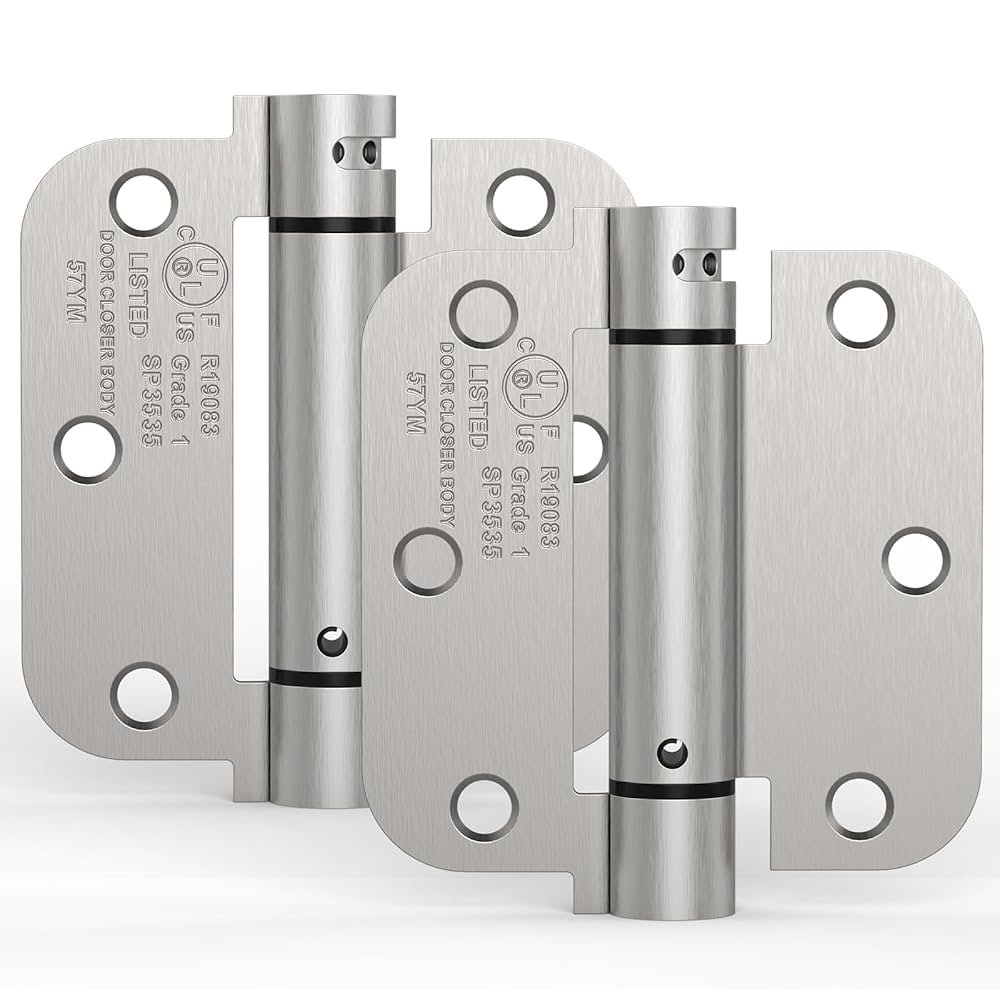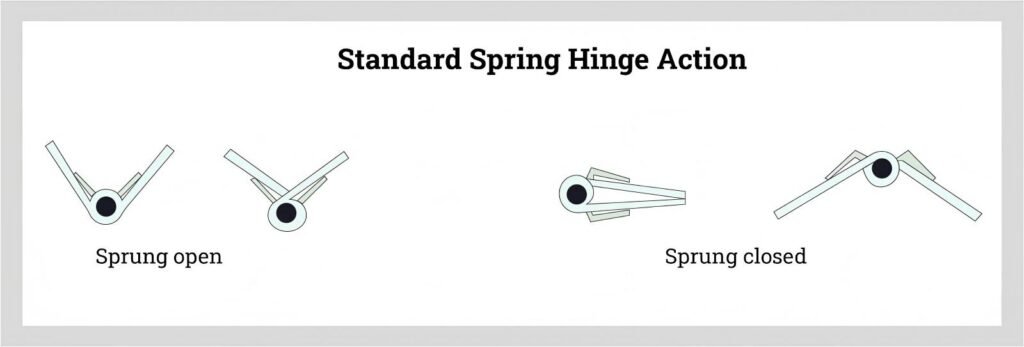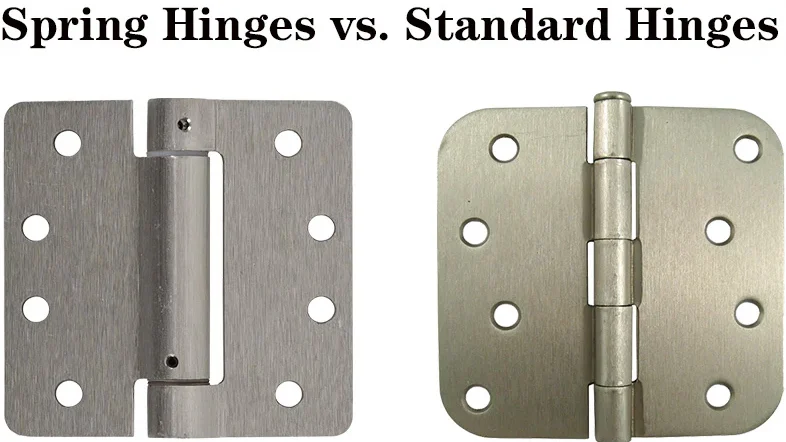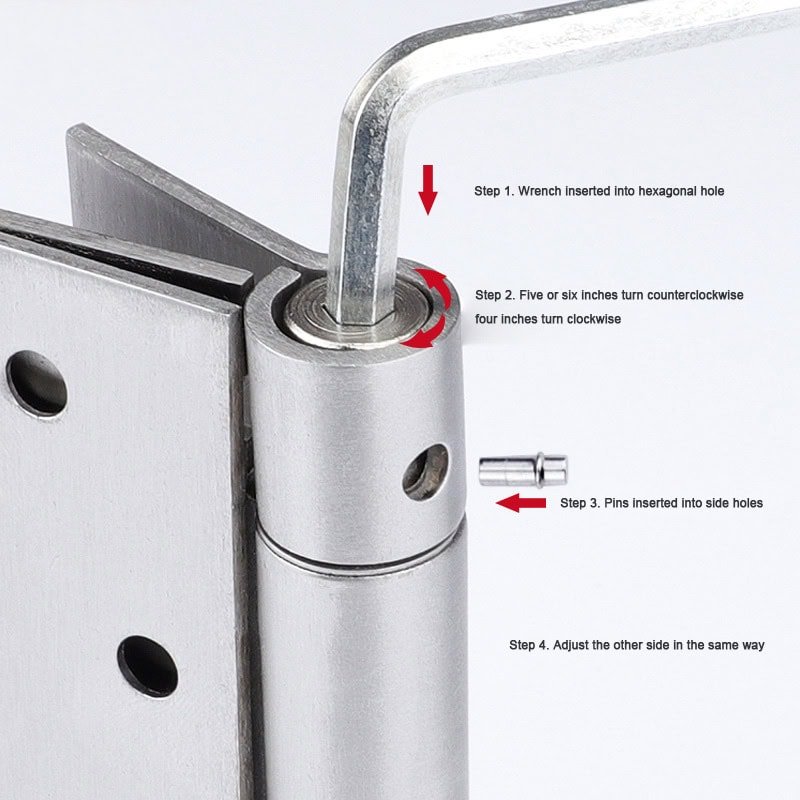🔸 What Are Door Hinges with Springs and How Do They Work?
How do commercial doors, garage entries, or utility room doors manage to close themselves without any visible door closer? Is there a simple mechanical solution that doesn’t require hydraulic systems or electrical components?
A door hinge with a spring—commonly known as a spring-loaded hinge—is a mechanical device that automatically returns the door to its closed position after opening. It uses a built-in torsion spring to generate rotational force, eliminating the need for manual closing. Once the door is opened, the spring stores energy and then releases it to pull the door shut.

These hinges are widely used in:
- Residential settings, such as garage-to-house doors and laundry rooms
- Commercial spaces, including service doors and small offices
- Exterior access points, where security and automatic closure are desired
🔧 Spring hinges are valued for their compact size, passive operation, and reliability in medium-traffic areas.
🔸What Are Spring Hinges and How Do They Work?
Spring hinges are mechanical door hardware devices equipped with torsion springs housed inside the barrel section. As the door opens, the spring compresses and stores energy. When released, the spring returns the door to its closed position—automatically and reliably, without electrical power or hydraulic assistance.
These hinges are widely used in both residential and commercial settings, especially where self-closing is needed for safety, airflow control, or privacy. Their compact design makes them ideal for situations where space-saving, maintenance-free solutions are preferred.

They are typically constructed from steel, stainless steel, or brass, and are available in a range of finishes and mechanical strengths to suit different applications.
✅ Two common mechanisms:
- Single-action spring hinges – Allow the door to open in one direction only, then self-close.
- Double-action spring hinges – Swing open in both directions and return to center automatically, commonly used in food service or light commercial settings.
🔸Types of Spring Hinges and Their Recommended Applications
Spring hinges come in a variety of designs to suit different environments and door types. Here’s a breakdown of the most common types and where they’re typically used:
- Interior Door Hinges with Springs Ideal for light to medium-weight wooden doors, such as those between a garage and living space or utility rooms. These hinges help prevent doors from remaining open and improve energy efficiency and safety inside the home.
- Exterior Door Hinges with Springs Manufactured with rust-resistant finishes or stainless steel, they are suitable for entryways exposed to weather, such as back doors, garden gates, or outdoor storerooms. Their self-closing function helps maintain security and insulation.
- Heavy Duty Door Hinges with Springs Designed to handle frequent use and higher door weights, these are often chosen for commercial buildings, workshops, or public entrances. Their construction supports longer service life even under demanding conditions.
- Self-Closing Hinges A general term for hinges that automatically bring a door back to the closed position. These can range from basic spring designs to more refined models with adjustable closing speed or tension.
- Spring Hinge Door Closers These combine spring action with mechanisms that offer a controlled, smoother closing motion. They’re a solid choice when you want auto-closing without the bulk of a full hydraulic system.
🛠 Practical Note: When choosing a spring hinge, consider the weight, size, and frequency of door use. The right match ensures reliable performance and long-term durability.
🔸 Sprung vs Unsprung Hinges: Which Should You Choose?
When specifying door hardware, understanding the difference between sprung and unsprung hinges is essential for selecting the right solution based on function, door type, and user expectations.

| Feature | Sprung Hinges | Unsprung Hinges |
|---|---|---|
| Self-closing function | ✅ Built-in spring mechanism enables auto-close | ❌ Requires external closer or manual closure |
| Push-to-open compatibility | ❌ Spring tension resists push-latch operation | ✅ Ideal for touch-latch and push-to-open systems |
| Mechanical complexity | Moderate – Includes torsion spring assembly | Low – Simple pin and barrel design |
| Maintenance | Requires occasional tension check or adjustment | Minimal – Static design with no moving parts |
🔍 Summary Tip: If your project demands automatic door return—for convenience, airflow control, or passive security—sprung hinges are the better option. For cabinets, display doors, or minimalist interiors that use push-to-open systems, unsprung hinges are the appropriate choice.
🔸Where to Use Interior Spring Hinges
Spring hinges used on interior doors offer a practical solution for spaces that require controlled access or passive closure without the bulk of additional door hardware.
Common use scenarios include:
- Garage-to-house access doors – Often installed for energy efficiency and to ensure the door closes behind occupants entering from a garage or carport.
- Laundry or utility rooms – Help contain moisture, sound, or cleaning chemicals within service areas.
- Pantry or storage doors – Maintain visual tidiness and prevent temperature or scent transfer.
- Basement entry doors – Useful in maintaining compartmentalization for thermal control or enhanced indoor air quality.
Interior spring hinges are generally:
- Designed for light to mid-weight wood or composite doors
- Finished in brushed nickel, oil-rubbed bronze, or white enamel to blend with residential décor
- Offered with adjustable spring tension to fine-tune door closing speed
🔸 Why Use Exterior Spring Hinges for Added Security
Spring hinges installed on exterior doors are valued for their contribution to security, energy control, and user safety, especially in doors that are regularly used or exposed to outdoor conditions.
Key benefits include:
- Automatic closure – Reduces the likelihood of doors being left open unintentionally, which helps control internal temperatures and protect entry points.
- Wind resistance – The spring mechanism prevents uncontrolled slamming during gusty weather or heavy use.
- Barrier against pests – Self-closing action helps seal the door after every use, reducing insect or rodent intrusion.
- Supports user flow – In busy service entrances or back-of-house operations, automatic closing improves hygiene and operational efficiency.
Exterior spring hinges are typically:
- Manufactured with weather-resistant coatings or stainless steel components
- Recommended for back doors, side entrances, garden gates, or detached structures
- Available in heavy-duty variants to support frequent operation and heavier door panels
🔸 Choosing Heavy Duty Spring Hinges for Industrial Applications
In industrial and commercial environments, door hardware must withstand high usage cycles, heavier doors, and strict functional demands. Heavy duty spring hinges are specifically designed to meet these challenges, offering strength, reliability, and extended service life.
These hinges are typically:
- Constructed from solid stainless steel or high-grade plated steel
- Rated for frequent, repeated use in heavy-traffic areas
- Capable of supporting door panels over 100 lbs
- Built with adjustable torsion springs to fine-tune closing force
🧱 Ideal applications include:
- Loading dock or warehouse access doors
- Commercial kitchen and service doors
- Office corridors with fire-rated partitions
- Durable shopfront or utility entrances
🛠 When selecting for industrial use, prioritize build quality, hinge thickness, and adjustability to ensure compatibility with door size and frequency of operation.
🔸What Are the Disadvantages of Spring Hinges?
While spring hinges offer many advantages, it’s important to understand their limitations—especially in high-performance environments:
- Limited speed control – Basic models don’t allow precise control over the door’s closing speed.
- Wear over time – Springs can lose tension, requiring occasional recalibration or replacement.
- Unsuitable for wide or heavy doors – May not provide sufficient force for large doors; alternative solutions like hydraulic closers might be better.
- Installation sensitivity – Incorrect alignment during installation may impact hinge performance or cause uneven closing.
📌 For demanding or large-scale applications, carefully assess whether spring hinges alone are sufficient, or if they should be used in combination with other door control systems.
🔸How to Adjust Spring Loaded Door Hinges
Proper spring tension adjustment ensures your door closes completely—without slamming or bouncing open. Here’s a step-by-step method:
🧰 Tools Required:
- Hex key (typically included with the hinge)
- Tension pin (included or substituted with a steel rod or small nail)

⚙️ Adjustment Steps:
- Locate the adjustment hole at the top of the hinge barrel.
- Insert the hex key into the hole and turn it clockwise to increase tension.
- Align the next hole and insert the pin to lock in the new tension setting.
- Test the door by opening and releasing it to observe closing behavior.
- Repeat as necessary until the door closes smoothly and fully.
⚠️ Safety Tip: Always keep hands and fingers away from the hinge barrel while adjusting tension. Spring force may release suddenly.
🔁 For double-action spring hinges, be sure to adjust both hinges equally to maintain balanced operation.
🔸 Summary
Spring hinges provide an effective, space-saving solution for self-closing doors in both residential and commercial settings. They’re easy to install, mechanically simple, and adaptable to a wide range of door types. If you’re looking to add automatic closure without complex mechanisms, spring-loaded hinges offer a practical and reliable choice.

